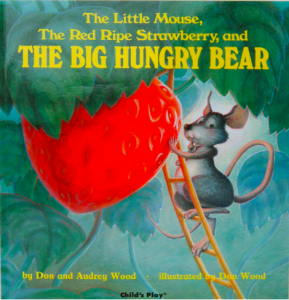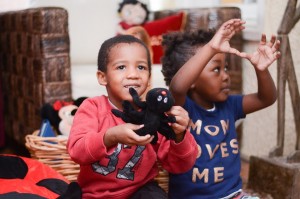There are so many benefits to reading with children…
But it can be difficult to keep a group of children engaged! Here are a few ways to make your story times more likely to bring children in and offer them the benefits that books can bring.
- Choose high quality literature. If you’re bored reading it, they’ll be bored listening. Look for interesting illustrations, distinctive characters, fun rhythm and rhyme, and relatable elements.
- Keep the books that get a good response, and shelve the ones that don’t capture their interest yet. Rotate books out when they’re getting stale and keep trying.
- Use your local library to keep an active rotation and try out new authors, illustrators, and genres. Plus, children’s librarians may have suggestions for books to read next.
- Books belong everywhere. Yes, a bookshelf or basket of books is important for children to have access to, but keep books about physics and great buildings with the blocks, keep books about plants in a waterproof box outside, and keep cookbooks with your play kitchen.
- Story time isn’t a set time— it’s whenever someone wants to read! Allowing children to engage with books when they’re interested and ready, and children who are allowed to freely choose when to listen to a story will enjoy them more. Plus, you can’t always tell who’s paying attention just based on where their body is– plenty of educators have heard a child across the room join in the chorus of a story.
- The last page isn’t a finish line: The goal is to engage children in the text. Whether that means dropping a book that the children aren’t interested in, or talking with them for 5 or 10 minutes about a single page, remember that it isn’t a race to the end. When children are asking questions or going off on tangents related to the subject or relating the story to their own experiences, they are internalizing the richness of text and its use as a tool for communication and connection.
What’s your favorite book to read with a group of children?
Young children are absorbing information from everything around them, but they haven’t yet developed a “filter” through which to assess that information, which is part of why it’s so important to discuss the media they are taking in with them directly.
I hope to introduce you to both specific books with excellent opportunities for conversation with young children, and also some jumping off points to carry into your discussions about books and other media as you consume it with the children in your care.
To start off, a classic: The Little Mouse, The Red Ripe Strawberry, and The Big Hungry Bear.
This is one of my favorite books to consciously introduce young children to the amount of information they can get from facial expressions and body language. Before reading it to the children, flip through and notice the huge variety of emotions that are readily apparent on the Little Mouse’s face. Pride, surprise, fear, regret, anxiety, confidence, and joy all stand out to me on different pages.
As you read, pause to notice out loud how the mouse appears to be feeling. Mimic the expression on your own face and see if the children do it as well. With older children, you can “wonder out loud” with statements like “I wonder what the mouse thinks the bear will do?” or “I wonder what he’s planning,” or invite discussion with prompts such as “I think he looks scared, here; look at his eyebrows. Do you see anything else that might tell me he’s scared?”
Using books to teach social-emotional competence gives children a low-stakes time to practice reading others’ emotions. When children haven’t had the opportunity to practice “reading” others’ faces, they have to learn on the fly, which can mean more conflict and more social struggles. For example, a three-year-old might not notice that the friend he’s chasing in a game of tag isn’t having fun anymore until that friend is in tears, rather than seeing his friend’s facial expression and other non-verbal cues and stopping the game.
Learning to read body language and facial expressions takes time and comes more easily to some children than others. When we take the time to consciously teach children about it, we can help build their empathic skills as they learn more about other people.
Stephanie Mckinstry from My Caterpillar Clubhouse, a Certified Nature Explore Classroom, shares how she incorporating books and images of nature into her program. Listen below for her tips.
This resource offers tips for choosing culturally responsive books for children and how to check for stereotyping and bias. There is a worksheet included that can be used when evaluating a children’s book and links to other helpful resources. Check out the Head Start National Center on Cultural and Linguistic Responsiveness for more information and resources.
Selecting Culturally Appropriate Books Resource
Read books to infants while you are holding them on your lap or be sure he/she can see the book. Any book with pictures will do, but board books work well for infants who often want to grab the pages or put the book in their mouth. Read for as long as the infant seems interested and don’t worry if you don’t make it all the way through the book. Allow the infant to touch and hold the book and read the same books many times. As infants gain more motor control allow them to turn the pages.
For a list of books by age click here.
Goal: To begin supporting infant’s language development and book knowledge.
Dr. Katie Paciga, Fred Rogers Fellow and Assistant Professor of Education, shares some things to consider when choosing e-books or storytelling apps.
When looking for e-books consider if there are different types of menu options such as “read to me”, “read and play”, “read by myself” which will offer flexibility for different ages and reading levels. Print tracking is another option that is excellent for emergent or beginning readers to draw attention to the words as they are being read. Check to see that any interactive elements relate to the story line and aren’t arbitrary, such that they draw attention away from the story or cause confusion. An option to record narration of the story can also be great for supporting children’s creativity.
Features of storytelling apps that are important to look for include the option to import images from the camera roll and the ability to use the keyboard or a finger for adding writing/text. The option to audio record so that the story can be told by the child’s voice rather than only by printed or written text makes a storytelling app more appropriate for a broad range of ages.
Several Chicago Public Library branches are offering a program for children birth to age five. story hour sessions are for children ages birth to 5. Enjoy reading, singing, nursery rhymes and fun activities designed to help support children’s language and literacy development. You can find out more about which branches are participating and dates and times for story hours at the Chicago Public Library Events page here: Library Events Link
If you are not located in the Chicago area you should check out your local library for activities and programs if you haven’t already. The library can be a great regular field trip destination for family child care to participate in story hour or just to browse and check out books.



